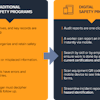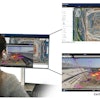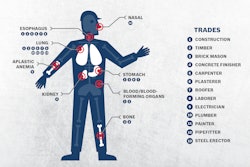
The Occupational Safety and Health Administration (OSHA) has issued a final rule on silica dust exposure. The goal of the new rule is to curb lung cancer, silicosis, chronic obstructive pulmonary disease and kidney disease in America's workers by limiting their exposure to respirable crystalline silica. The rule is comprised of two standards, one for Construction and one for General Industry and Maritime.
Key provisions
- Reduces the permissible exposure limit (PEL) for respirable crystalline silica to 50 micrograms per cubic meter of air, averaged over an 8-hour shift (previous limit was 250 micrograms).
- Requires employers to: use engineering controls (such as water or ventilation) to limit worker exposure to the PEL; provide respirators when engineering controls cannot adequately limit exposure; limit worker access to high exposure areas; develop a written exposure control plan, offer medical exams to highly exposed workers, and train workers on silica risks and how to limit exposures.
- Provides medical exams to monitor highly exposed workers and gives them information about their lung health.
- Provides flexibility to help employers — especially small businesses — protect workers from silica exposure.
Compliance schedule
Both standards contained in the final rule take effect on June 23, 2016, after which industries have one to five years to comply with most requirements, based on the following schedule:
Construction - June 23, 2017, one year after the effective date.
General Industry and Maritime - June 23, 2018, two years after the effective date.
Hydraulic Fracturing - June 23, 2018, two years after the effective date for all provisions except Engineering Controls, which have a compliance date of June 23, 2021.
OSHA estimates that the rule will save over 600 lives and prevent more than 900 new cases of silicosis each year, once its effects are fully realized. The Final Rule is projected to provide net benefits of about $7.7 billion, annually.
About 2.3 million workers are exposed to respirable crystalline silica in their workplaces, including 2 million construction workers who drill, cut, crush, or grind silica-containing materials such as concrete and stone, and 300,000 workers in general industry operations such as brick manufacturing, foundries, and hydraulic fracturing, also known as fracking.
Most employers can limit harmful dust exposure by using equipment that is widely available — generally using water to keep dust from getting into the air or a ventilation system to remove it from the air. The rule provides greater compliance assistance to construction employers — many of which run small businesses — by including a table of specified controls they can follow to be in compliance.
U.S. Secretary of Labor Thomas E. Perez wrote a blog post for more information, which includes a video featuring one worker's personal experience with silicosis. Visit OSHA's silica rule webpage for factsheets, answers to frequently asked questions, and to sign up for email updates on compliance dates and resources.



















